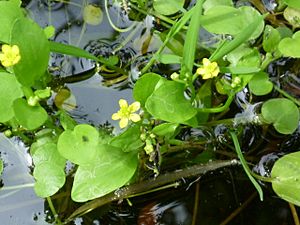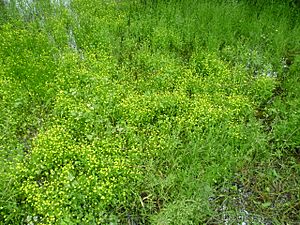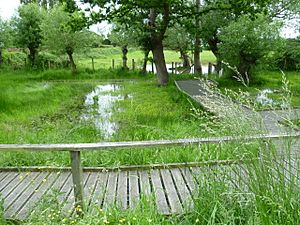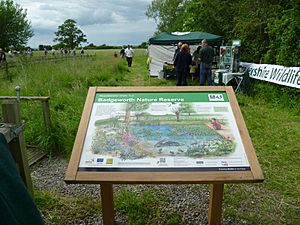Badgeworth SSSI, Gloucestershire facts for kids
| Site of Special Scientific Interest | |

Closeup of flowering of Adder's-tongue Spearwort at the Badgeworth nature reserve in June 2012
|
|
| Area of Search | Gloucestershire |
|---|---|
| Coordinates | 51°53′04″N 2°07′48″W / 51.884338°N 2.129985°W |
| Interest | Biological |
| Area | 3.08 hectare |
| Notification | 1954 |
Badgeworth SSSI is a special natural area in Gloucestershire, England. It's about 3 football fields big (3.08 hectares). This place was first recognized as important in 1954 because of its unique plants and animals. A big part of this area is a nature reserve, looked after by the Gloucestershire Wildlife Trust.
This site is super special because it's one of only two places in the whole United Kingdom where a rare plant called the Adder's-tongue Spearwort grows! In Gloucestershire, people often call it the "Badgeworth buttercup" because it's so connected to this reserve. The reserve is close to the village of Badgeworth. The only other place this plant grows is at Inglestone Common in South Gloucestershire.
This area is like a natural dip in the ground, made of a type of clay called Blue Lias. It fills up with rainwater and water from nearby fields during certain times of the year. This creates a wet, marshy home that the special Adder's-tongue Spearwort plant needs to grow.
Contents
History of Badgeworth Reserve
The Badgeworth nature reserve has a long and interesting history. It started very small in 1935, covering only about 290 square meters. In 1964, it was even listed in the Guinness World Records as the world's smallest nature reserve!
More land was added over time. In 1975, another 100 square meters joined the reserve. Then, in 2002, a whole field was added. The main wet area is known as Cold Pool, and the part added in 1975 is called Warren's Pool.
People have known about the Adder's-tongue Spearwort growing here since 1890. The site was given to a group called the Society for the Promotion of Nature Reserves (now the Royal Society of Wildlife Trusts) in 1933. This made it the very first official nature reserve in Gloucestershire.
A local team was formed to manage the area. They put up fences and gates, and built walkways so people could visit without getting too wet. Today, the reserve still has these walkways for visitors. It's usually kept locked, but there's an annual Open Day when everyone can come and see the famous buttercup.
The reserve was given to the Gloucestershire Trust for Nature Conservation (now the Gloucestershire Wildlife Trust) in 1962. It was the first reserve this Trust managed in Gloucestershire, and they have owned it since 1991.
About the Adder's-tongue Spearwort Plant
The Adder's-tongue Spearwort is a unique plant that grows here. It's an annual plant, meaning it lives for one year, and usually flowers in late May.
Its roots are long and spread out from the lower parts of its stem. The stems and leaves are a pale yellowish-green, and the top of the leaves are shiny. The name "Adder's-tongue" or "Snake's-tongue" comes from the shape of its leaves.
The flowers are quite small and have bright canary-yellow petals. One plant can have many flowers, and they produce lots of seeds. In 1991, some of these seeds were collected and stored in the Millennium Seed Bank Partnership to help protect the species.
Wildlife at Badgeworth
The Badgeworth reserve is home to many different plants and animals. The number of Adder's-tongue Spearwort plants changes each year. It depends on the weather, especially when the seeds sprout in the autumn. They usually flower in June.
This wet area also supports other interesting plants, including:
- Lesser Spearwort
- Common water-crowfoot
- Narrow-leaved Water-plantain
- Marsh Speedwell
- Pink Water-speedwell
- Fen Bedstraw
- Marsh Foxtail
Beyond plants, the reserve is a great place for insects and amphibians. From 1963 to 2008, 305 different types of beetles were found here! The ponds are also breeding grounds for Common frogs and different kinds of Newts, like Great Crested, Smooth, and Palmate newts.
Protecting the Reserve
Looking after Badgeworth is very important to make sure the Adder's-tongue Spearwort continues to thrive. In the autumn, thick patches of plants like Reed Sweet-grass and Creeping Bent are carefully removed. This creates bare patches of soil, which the Adder's-tongue Spearwort seeds need to grow.
The willow trees nearby are also trimmed in a special way called "pollarding." This helps control how much light reaches the ground and manages the water levels in the wet areas.
There's a worry that the growing town of Cheltenham could threaten this special plant population. To help protect it, a new pond has been built at the far end of the reserve. The hope is to start another group of Adder's-tongue Spearwort plants there. A few flowers have already appeared, possibly from old seeds in the soil or seeds carried by animals or birds.




